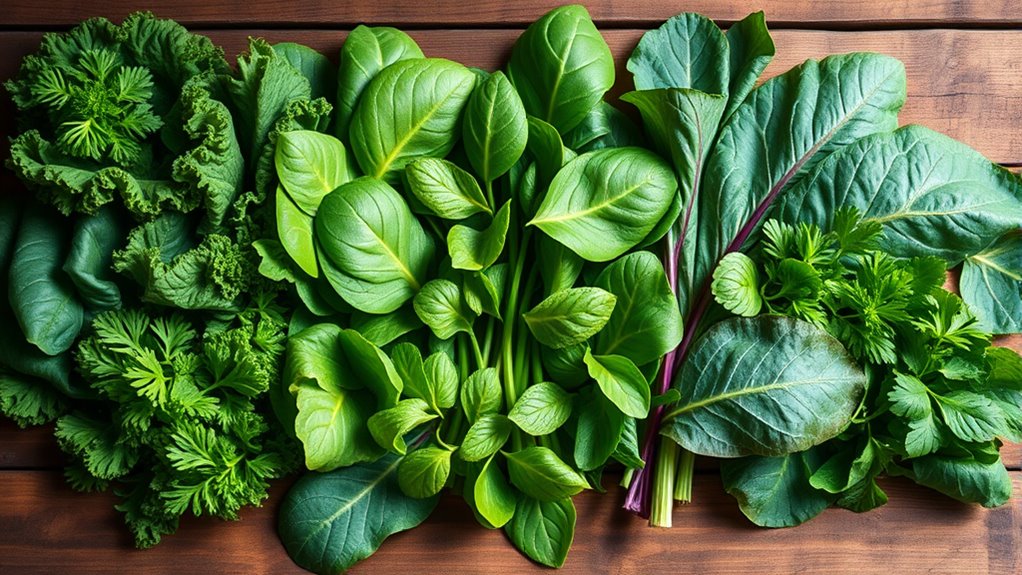If you want to revolutionize your juicing, start with romaine for hydration, spinach for nutrients, and kale for a superfood boost. Swiss chard adds vitamins, while celery refreshes your blends. Don’t forget beet greens for an earthy touch, collard greens for flavor, and mustard greens for a spicy kick. For an extra nutritional boost, toss in parsley. Each green has unique benefits that elevate your juices. Discover how to maximize these greens in your juicing journey!
Key Takeaways
- Incorporate hydrating greens like romaine lettuce and celery for refreshing, high-water-content juices that enhance hydration.
- Utilize nutrient-dense leafy greens such as spinach and kale to maximize vitamins and minerals in your juice blends.
- Experiment with flavorful greens like mustard and collard greens to add unique tastes and nutritional benefits to your juices.
- Combine earthy beet greens with other vegetables to enhance flavor while boosting antioxidants and phytonutrients.
- Utilize juicing techniques like pairing fibrous greens with high-yielding veggies to enhance texture and juice volume.
Romaine: The Juicing Powerhouse
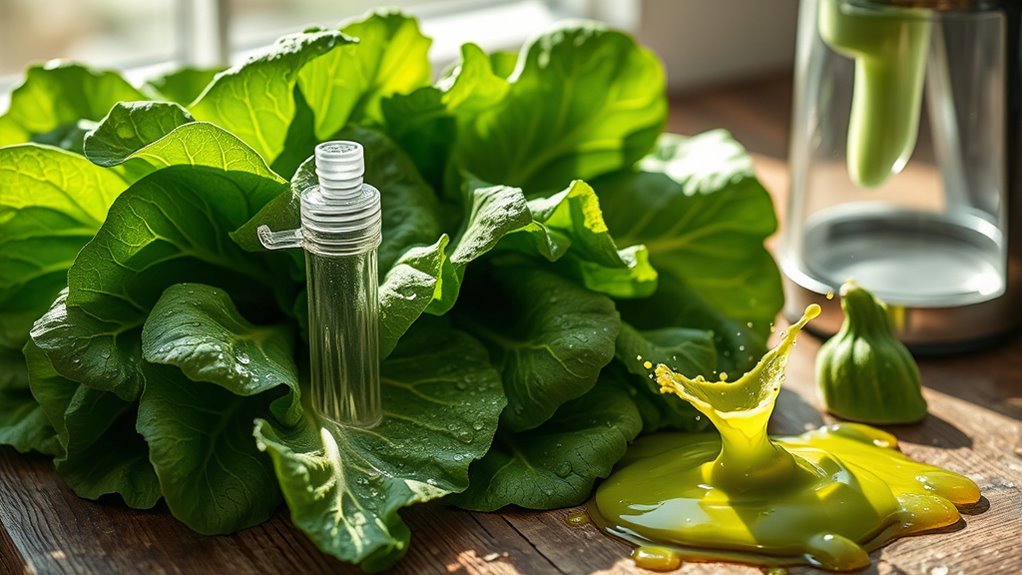
When you think about juicing leafy greens, romaine lettuce stands out as a true powerhouse. It produces nearly twice the juice compared to kale, chard, and spinach, making it incredibly efficient for your juicing endeavors.
While its nutrient profile isn’t as high as some other greens, romaine serves as a fantastic base, allowing you to mix in more nutrient-dense options. Priced at around $2.50 per bunch, it offers excellent value for the juice you get.
Plus, romaine’s high water content makes it a hydrating addition to any blend. By incorporating romaine into your juices, you enhance both flavor and volume, creating delicious blends while maximizing health benefits with richer greens. Additionally, juicing fresh leafy greens can significantly boost your overall nutrient intake.
Spinach: Nutrient-Dense and Versatile
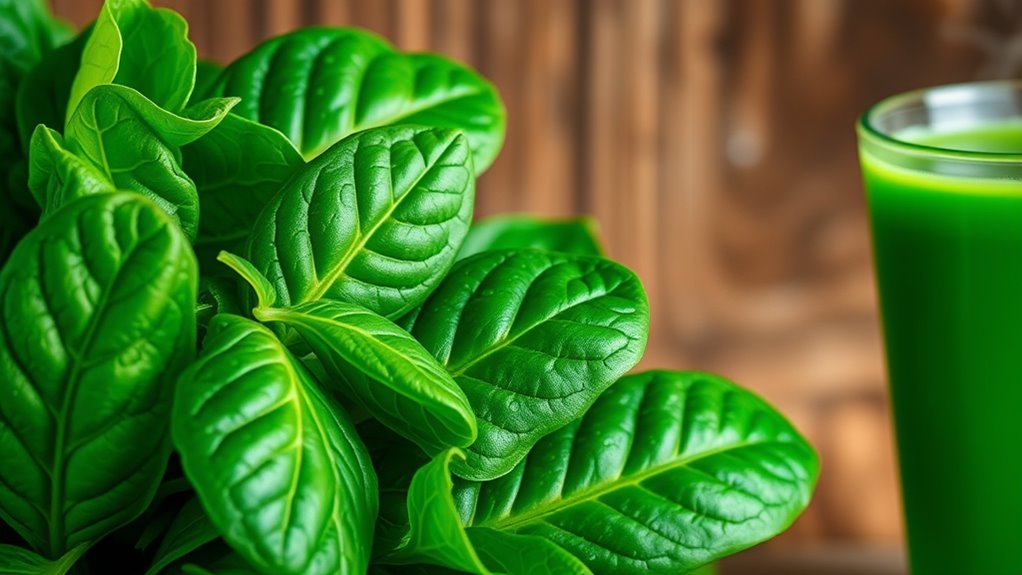
Spinach packs a powerful nutritional punch, making it a fantastic choice for your juicing routine.
Just remember to rinse it well to get rid of any sand, and you’ll find it blends easily with other fruits and veggies.
With its versatility and health benefits, spinach is sure to elevate your juice game.
Nutritional Powerhouse Benefits
Packed with essential nutrients, spinach stands out as a nutrient-dense powerhouse that can greatly boost your overall health.
It’s rich in vitamins A, C, and K, along with iron and folic acid, making it an excellent source of vitamins and minerals. A 2019 study even showed that spinach consumption could improve gut microbiota, enhancing your digestive health.
Its mild flavor makes spinach versatile for juicing, allowing you to pair it with various fruits and vegetables. When juicing, you’ll benefit from its concentrated nutrient density, giving you a powerful boost in vitamins with every sip. Additionally, essential oils can enhance the effectiveness of traditional cleaning agents, making it easier to maintain a clean kitchen for your juicing prep.
Just remember, cleaning spinach can be a chore due to sand, so opting for bunched spinach might save you time and money.
Juicing Preparation Tips
To make the most of your juicing experience, prepping spinach properly is key. Spinach is a nutrient-dense leafy green that enhances your juice’s flavor and health benefits. Here are some juicing preparation tips to take into account:
| Tip | Description | Benefits |
|---|---|---|
| Buy Pre-Washed Spinach | Saves time but may cost more | Convenience |
| Use Two-Thirds Bunch | Achieves similar volume to kale and chard | Consistent juice yield |
| Clean Thoroughly | Rinse to remove sand and dirt | Guarantees cleaner juice |
| Incorporate Variety | Mix with other greens for diverse flavors | Nutrient diversity |
| Store Properly | Keep in a sealed bag in the fridge | Maintains freshness |
With these tips, you’ll enjoy delicious spinach juices packed with nutrients! Additionally, storing juice in airtight containers can help maintain its freshness longer.
Kale: A Superfood for Your Juices
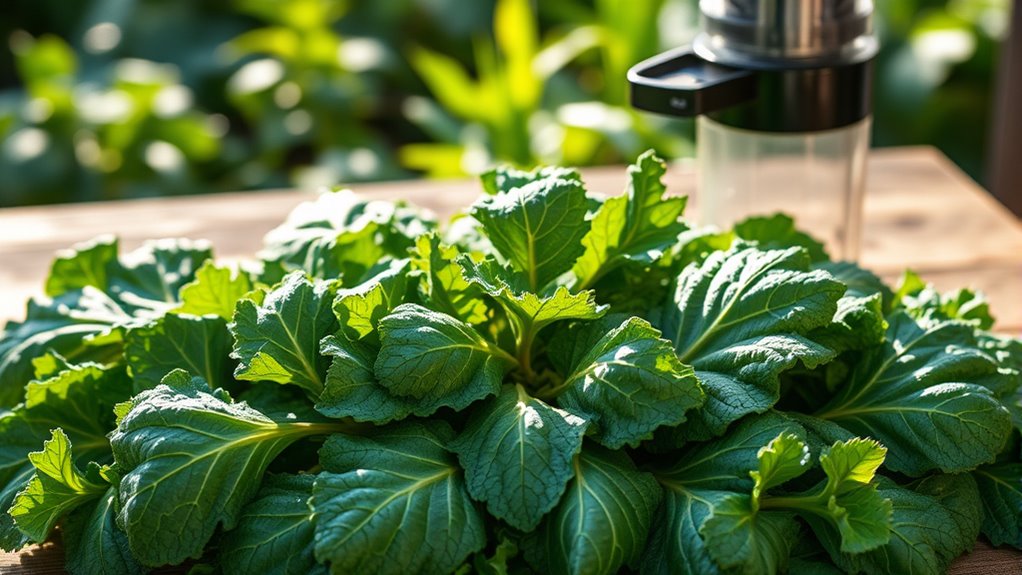
When you’re looking to boost your juice with nutrient-rich greens, kale stands out as a powerhouse. This superfood is packed with vitamins A, K, C, and B6, along with essential minerals like calcium and potassium.
Kale’s high antioxidant content helps combat oxidative stress and inflammation, making it a fantastic addition to your juicing routine. Although its fibrous texture yields less juice than other greens, combining kale with higher-yielding vegetables like cucumber or celery enhances your drink’s nutritional profile. To balance kale’s slightly bitter taste, mix it with sweeter fruits like apples or pineapples for a deliciously palatable blend. Incorporating kale into your juices supports your overall health and adds a vibrant green hue to your creations. Additionally, consider adding chia seeds to your juice for an extra boost of omega-3 fatty acids and fiber.
Swiss Chard: Rich in Vitamins and Minerals
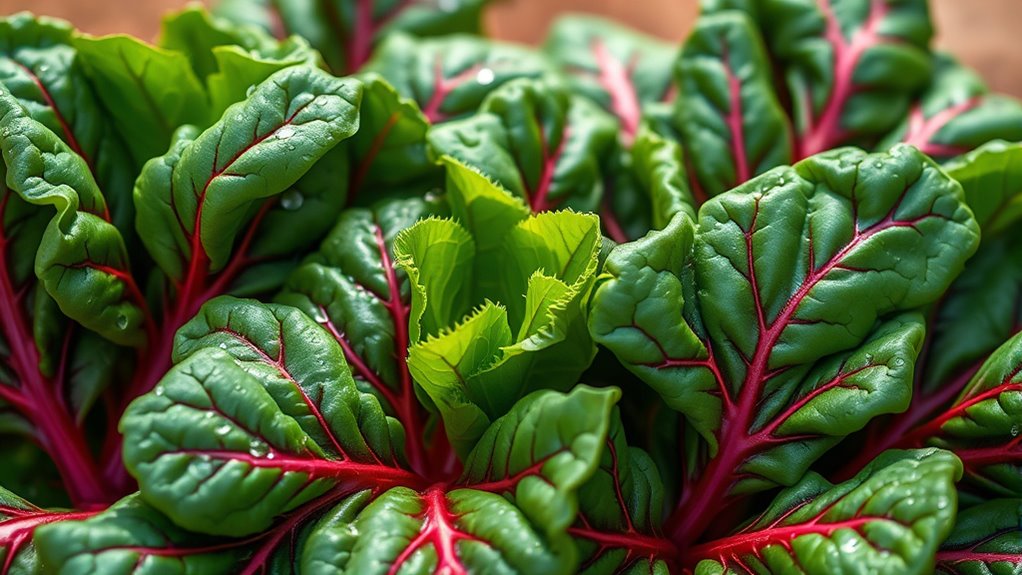
Swiss chard stands out as a vibrant addition to your juicing routine, offering a wealth of vitamins and minerals. It’s packed with vitamin K, along with vitamins A, C, magnesium, and fiber. These nutrients support overall health and enhance your juice’s nutritional profile. Plus, Swiss chard’s antioxidants, like beta-carotene and lutein, help reduce chronic disease risks and boost eye health. Incorporating nutritional information about Swiss chard into your diet can further optimize your health.
| Nutrient | Amount per 100g | Benefits |
|---|---|---|
| Vitamin A | 306 µg | Supports vision and immune |
| Vitamin K | 830 µg | Essential for blood clotting |
| Magnesium | 81 mg | Promotes muscle function |
| Fiber | 1.6 g | Aids digestion |
| Flavonoids | Varies | Reduces inflammation |
Including Swiss chard in your juices not only adds flavor but also promotes a healthy gut microbiome.
Celery: Hydrating and Refreshing
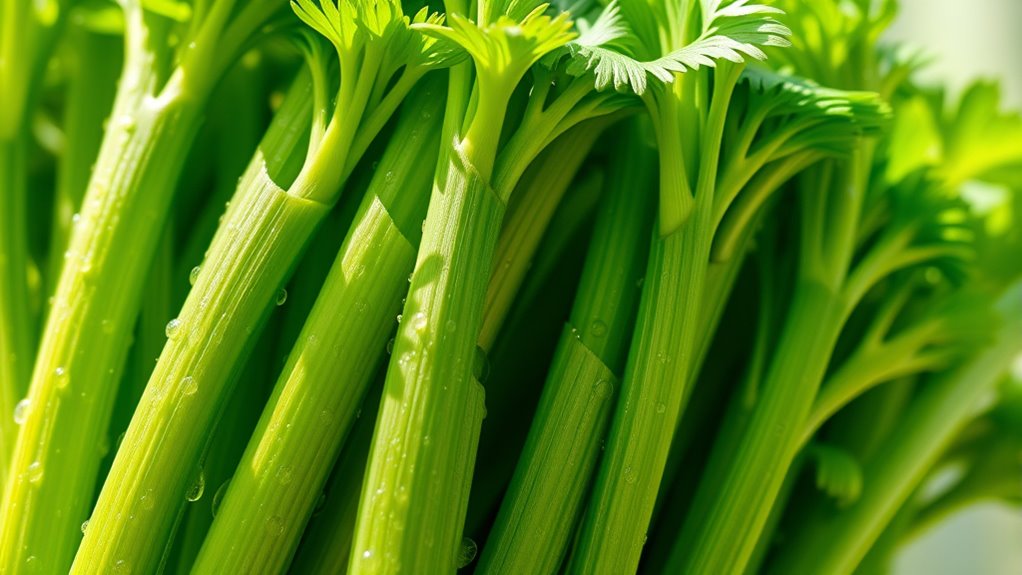
Celery is a fantastic addition to your juice, not just for its invigorating taste but also for its impressive nutritional profile. Packed with vitamins, minerals, and antioxidants, it supports your overall health while keeping you hydrated. Whether you’re looking for new juicing recipes or simply want to enjoy its benefits, celery is a great choice. Additionally, incorporating high fiber content into your diet can aid digestion and enhance satiety.
Nutritional Benefits of Celery
Although often overlooked, celery packs a punch when it comes to hydration and nutrition. With about 95% water content, it’s incredibly invigorating and perfect for keeping you hydrated.
This crunchy veggie is rich in essential nutrients like vitamin K, folate, and potassium, all of which play significant roles in maintaining your overall health. Vitamin A also makes an appearance, supporting your vision and immune system.
Plus, the low-calorie count—just 16 calories per 100 grams—makes it a fantastic choice if you’re looking to manage your weight. The anti-inflammatory phytochemicals found in celery may help reduce the risk of chronic diseases, while its fiber content promotes digestive health, making it a powerhouse for your juicing routine. Additionally, celery juice is known for its hydration and electrolyte balance benefits, making it an excellent addition to your health regimen.
Celery in Juicing Recipes
Wondering how to make your juicing routine even more rejuvenating? Celery is your answer! With about 95% water, it’s incredibly hydrating, keeping you revitalized in every sip.
Adding celery to your vegetable juices not only enhances the flavor but also introduces essential vitamins K and C, plus folate, which promote overall health. Plus, its natural sodium content means you can skip the added salt while still enjoying a delicious taste.
If you’re looking to manage your weight, celery’s low-calorie nature is perfect. You might even find it helps reduce blood pressure and alleviate bloating. Additionally, incorporating raw nutrition bars into your diet can provide an excellent source of energy to complement your juicing routine.
Cucumber: The Perfect Juicing Companion

When you’re looking to create a revitalizing juice, cucumber stands out as the perfect companion. Composed of about 95% water, cucumber adds hydrating rejuvenation to your cucumber juice while enhancing the overall flavor without overpowering it.
Packed with essential vitamins and minerals like potassium and vitamin A, it boosts the nutritional value of your drinks. Plus, cucumber juice is known for its anti-inflammatory properties, helping soothe skin irritation and promoting healthy skin. Additionally, cucumber’s high water content makes it an excellent addition to detoxifying juices, aiding in the elimination of toxins from the body.
With its low calorie content, it’s ideal for anyone wanting to maintain a healthy weight while enjoying delicious flavors. Add cucumber to your juicing routine, and you’ll discover a revitalizing, versatile ingredient that elevates every sip!
Beet Greens: An Often Overlooked Gem
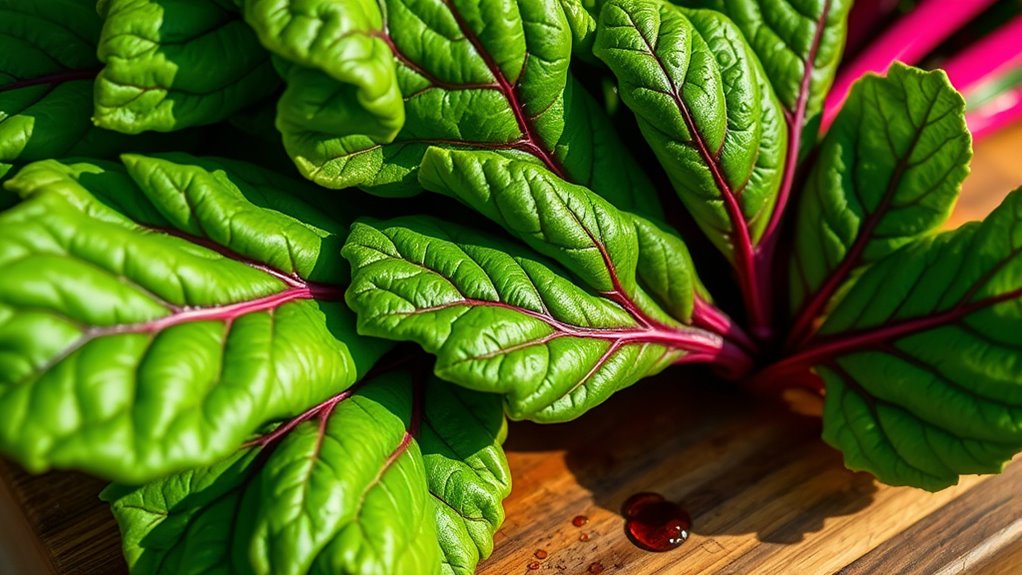
Cucumber’s invigorating qualities are just the beginning of your juicing adventure.
Don’t overlook beet greens, the leafy tops of beets that are packed with vitamins A, C, and K, along with calcium and iron.
These nutrient-rich greens not only enhance the flavor of your juices with their slightly earthy and sweet taste, but they also contribute antioxidants and phytonutrients that may help reduce inflammation and combat oxidative stress in your body. Additionally, beet greens are low in calories and high in fiber, making them a great option for weight management-friendly options in your diet.
Juicing them fresh or blending them into smoothies is an easy way to boost your vegetable intake without adding extra calories.
Collard Greens: Robust and Flavorful
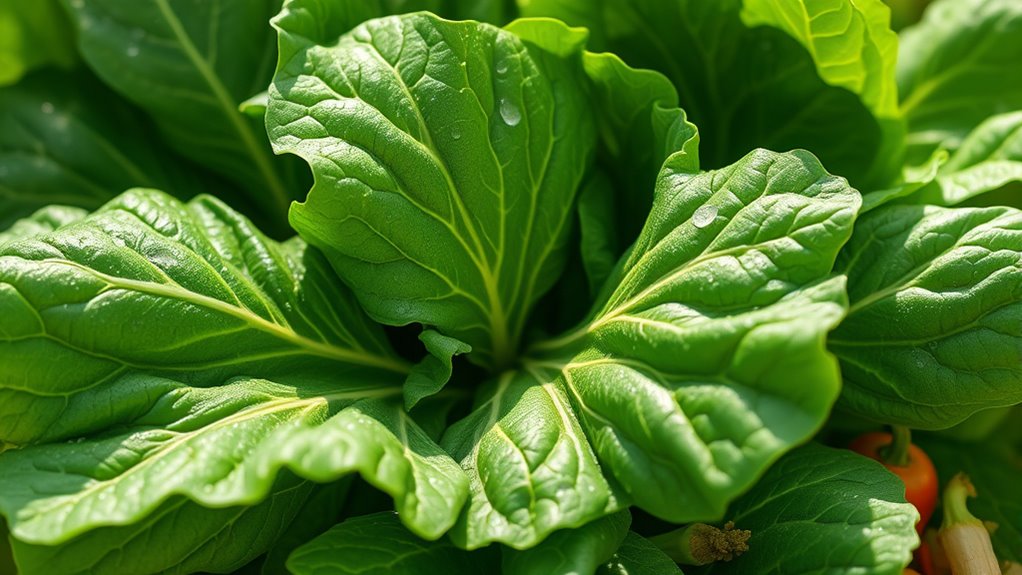
Collard greens pack a powerful nutritional punch, loaded with essential vitamins and minerals that boost your health.
When you juice them, their robust flavor can enhance your drink, especially when mixed with sweeter fruits.
Let’s explore some juicing techniques and tips to make the most of these leafy greens!
Nutritional Benefits Overview
Although often overlooked, collard greens are a powerhouse of nutrition that can enhance your juicing routine. Packed with vitamin C, they support your immune system while also providing vitamins A and K, essential for overall health.
The high calcium content in collard greens promotes strong bones and teeth, aiding muscle function as well. Plus, their excellent source of dietary fiber helps with digestion and can assist in weight management.
Collard greens also contain antioxidants that combat oxidative stress and reduce inflammation in your body. Best of all, they’re low in calories, making them a smart addition to your diet without unnecessary extra calories.
Embrace the nutritional benefits of collard greens in your next juice!
Juicing Techniques and Tips
When it comes to juicing collard greens, mastering a few techniques can elevate your drink from ordinary to exceptional. Start by removing the tough stems to improve texture. Since collard greens yield less juice, pair them with higher-yielding veggies like cucumbers or romaine. To balance their robust flavor, mix them with sweeter fruits such as apples or oranges. You can also boost health benefits by adding ginger or turmeric. Here’s a quick reference table:
| Technique | Tips |
|---|---|
| Stem Removal | Remove tough stems for better texture |
| Pairing | Combine with sweeter fruits |
| Mixing Greens | Use higher-yielding greens |
| Flavor Boost | Add ginger or turmeric |
These juicing techniques will make your collard greens shine!
Mustard Greens: Spicy and Nutrient-Rich
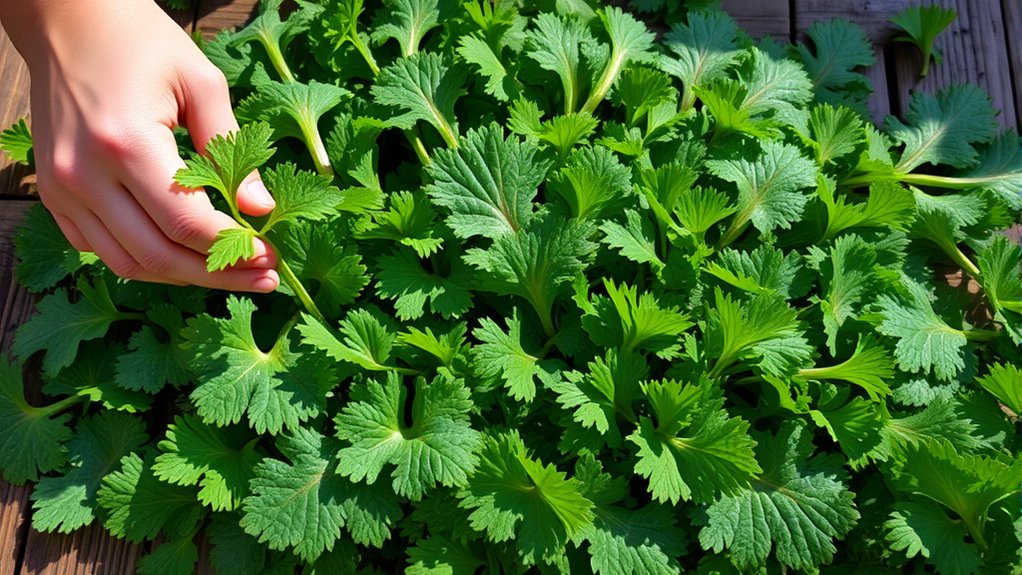
Mustard greens pack a flavorful punch that can elevate your juicing experience, thanks to their unique peppery taste and impressive nutrient profile.
These cruciferous vegetables are rich in vitamins A, C, and K, giving your juice a significant health boost. They also contain essential minerals like calcium and iron, making them an excellent choice for enhancing your nutritional intake.
Low in calories and high in fiber, mustard greens aid digestion and promote feelings of fullness, which is great if you’re managing your weight.
Plus, their glucosinolates may offer anti-cancer properties and support liver detoxification.
When juiced, they add a spicy kick that perfectly complements sweeter fruits and milder veggies, making your drink both exciting and nutritious.
Parsley: A Flavorful Nutritional Booster
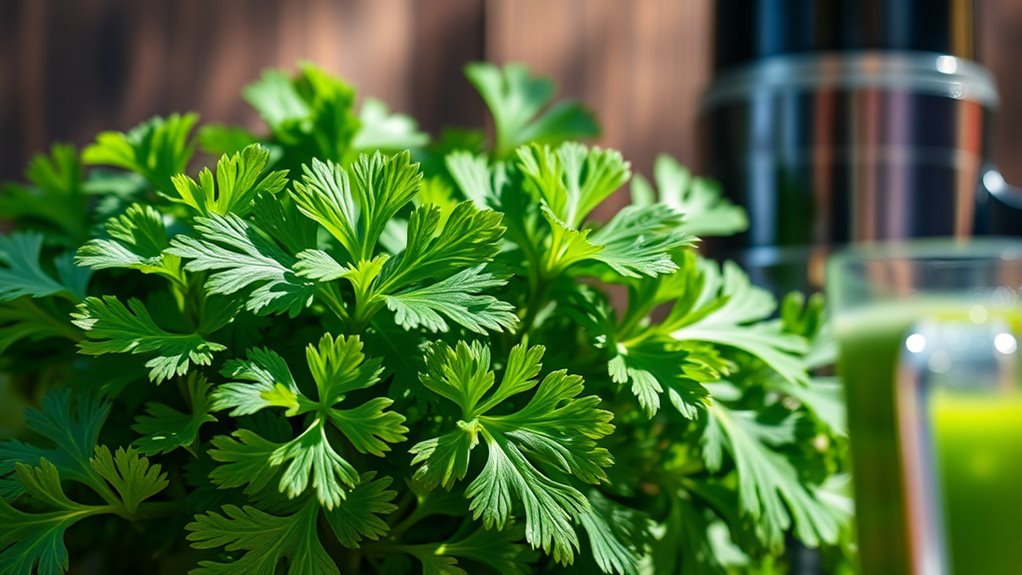
Parsley is more than just a garnish; it’s a powerhouse of nutrition that can elevate your juicing game. Packed with vitamins A, C, and K, parsley serves as a flavorful nutritional booster, enhancing the nutrient profile of your drinks.
Its high antioxidant content, including flavonoids, helps combat oxidative stress and inflammation, making your juices even more beneficial. Anecdotal evidence suggests parsley may act as a natural diuretic, aiding in reducing high blood pressure and bloating.
Plus, a 2016 study hints at its potential to protect liver health, although more research is needed. By adding parsley to your juices, you’re not only boosting flavor but also packing in serious health benefits for a revitalizing experience.
Frequently Asked Questions
Which Leafy Greens Are Best for Juicing?
When you’re looking for the best leafy greens for juicing, consider romaine lettuce for its high yield and affordability.
Spinach is also a great choice, offering a rich nutrient profile, though it needs a bit of washing.
Kale and Swiss chard are nutrient-dense, but they yield less juice.
Mixing in high-water greens like cucumber and celery can enhance hydration and balance your juice, making it both invigorating and nutritious.
What Is the 80/20 Rule for Juicing?
The 80/20 rule for juicing is like discovering a secret potion for health!
It suggests you fill your juice with 80% leafy greens, like kale and spinach, while adding just 20% fruits for sweetness.
This balance keeps your juice packed with nutrients without overwhelming it with sugar.
What Vegetable Is Best for Juicing?
When you’re deciding on the best vegetable for juicing, consider romaine lettuce. It yields nearly double the juice compared to kale, chard, and spinach.
However, don’t overlook spinach; it’s rich in vitamins A, C, K, and iron, making it a great choice too.
For a nutrient boost, mix romaine with other greens like kale or chard. This way, you’ll maximize both your juice yield and nutritional value in every glass.
What Are the Best Vegetables to Juice for Detox?
When you’re looking to detox through juicing, certain vegetables stand out. Kale and spinach are packed with essential vitamins and phytonutrients that support liver health.
Adding Swiss chard boosts your juice with antioxidants, while celery hydrates and helps reduce bloating.
Don’t forget parsley for its diuretic properties, and beets to enhance liver detoxification.
Combining these veggies creates a nutrient-rich juice that aids in flushing out toxins and revitalizing your body.
Conclusion
Incorporating these ten green leafy veggies into your juices can truly transform your health and wellness journey. While some may think they can’t enjoy the taste of greens, the truth is that blending them with fruits can create delicious, nutrient-packed beverages. Experiment with different combinations to find your perfect mix—who knows, you might just discover a newfound love for greens! So grab your juicer and start revolutionizing your daily routine today; your body will thank you!
Cindy thoroughly researches juicing trends, techniques, and recipes to provide readers with practical advice and inspiration. Her writing style is accessible, engaging, and designed to make complex concepts easy to understand. Cindy’s dedication to promoting the advantages of juicing shines through her work, empowering readers to make positive changes in their lives through the simple act of juicing.

